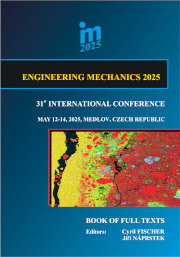Proceedings Vol. 31 (2025)

ENGINEERING MECHANICS 2025
May 12 – 14, 2025, Medlov, Czech Republic
All papers were reviewed by members of the scientific committee.
ISBN 978-80-86246-99-4 (electronic)
ISSN 1805-8248 (printed)
ISSN 1805-8256 (electronic)
scientific committee — home
Chapter 1: Keynote Lectures
This paper presents two advanced in-situ X-ray imaging facilities developed for studying material behavior under dynamic loading conditions at both intermediate and high strain rates. The first facility, optimized for intermediate strain rate testing using an apparatus based on linear motors, utilizes continuous axial X-ray radiography to capture internal material processes during impact testing, with frame rates ranging from 100 fps to 500 fps using a laboratory camera, and up to 2000 fps using a high-speed camera. The second facility, designed for high strain rate testing, integrates a flash X-ray system capable of capturing ultra-high-speed events with frame rates in the tens of thousands of frames per second. This imaging system is coupled with modular Split Hopkinson Bar, Direct Impact Hopkinson Bar, and Open Hopkinson Pressure Bar devices for dynamic material testing, enabling precise measurements of force, velocity, and displacement. The facilities have enabled successful visualization and analysis of complex deformation and failure mechanisms in various materials, providing significant insights into deformation response under dynamic conditions. Despite challenges related to resolution, frame rates, and contrast, these systems offer valuable insights with the potential for further optimization and comparison with particle-accelerator based results.
The application of pre-stressed tendons and ropes has an essential influence on architectural expression, new structural concepts and economy of various types of steel structures. Especially advantageous re-distribution of the internal forces acting against those resulting from self weight and action of external loads is positive effect of the global pre-stressing of steel structures. Structures can be also simply pre-deformed in order to avoid or reduce deformations caused by self weight and other applied loadings. Examples of long span roofs, bridges and other pre-stressed structures are introduced in this paper. Methods of pre-stressing, force measurements and recommendations for design and construction are presented.
Geometric flows describe the evolution of shapes driven by geometric quantities such as curvature. While originating in pure mathematics, where they played a central role in milestones like the proof of the Poincaré conjecture, these flows also have a rich history of applications across science and engineering. In this paper, we provide a brief overview of the key ideas behind geometric flows, focusing on curve and surface evolution in Euclidean space, and highlight their relevance to modeling dislocation lines in crystals, vortex filaments in fluids, and optimal structural forms in engineering. Our aim is to provide a concise but selfcontained exposition, emphasizing the conceptual beauty and broad utility of this mathematical framework.
Copyright © 2025 Institute of Theoretical and Applied Mechanics, Czech Academy of Sciences, Prague
All contributions are published under the Creative Commons Attribution 4.0 International License (CC BY 4.0). The copyright remains with the authors. The texts are publicly accessible, and any reuse must include appropriate credit to the original source as required by the license.
